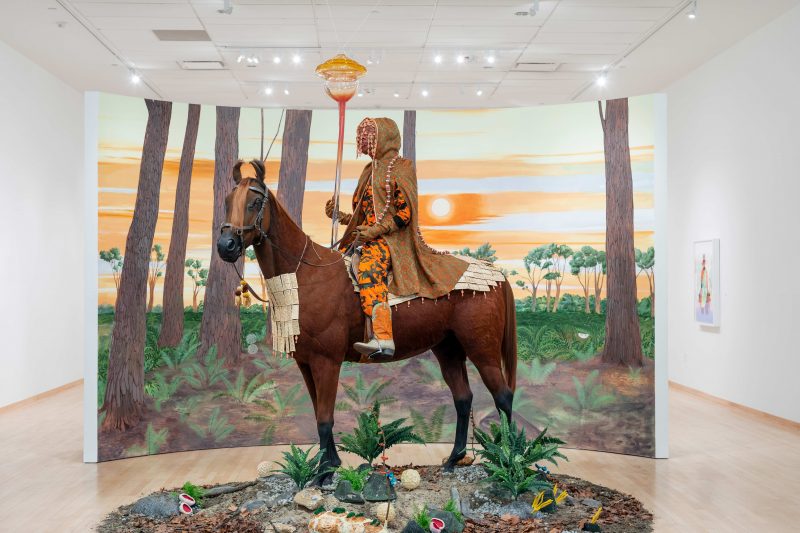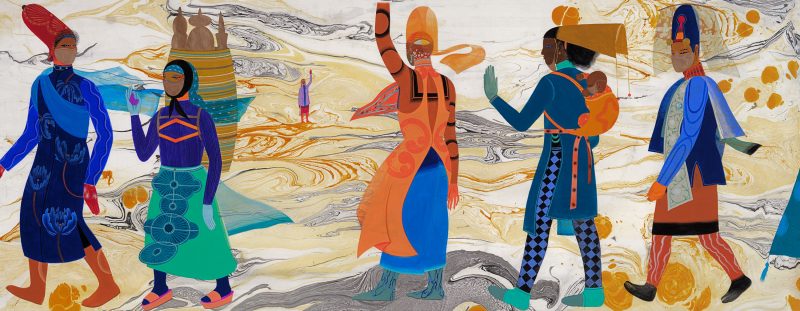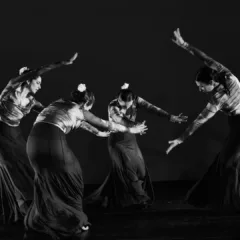Tucked away inside the Tyler School of Art, in the Temple Contemporary gallery, is the futuristic solo exhibition titled Beyond the Words of Earth by Toronto-based artist Rajni Perera, in which she synthesizes science fiction with post-imperialist capitalism. The exhibit is a combination of paintings, sculptures, and an installation that all speculate on a post-apocalyptic future where the heirs to this regenerated Earth are immigrants. According to the exhibition wall text:
After the end of an ecological collapse induced by human greed, apathy and unstoppable natural resource depletion due to extraction by wealthy nations, beings called Travelers–the formerly oppressed–are now victorious. The humanoid species who are mutations of immigrants have unwittingly inherited the dregs of a tired planet and begin to offworld…
Here, Perera lays the groundwork for the tricky intersection of environmental imperialism and its looming aftermaths that her works address.
The most visually striking piece, titled A Starry-eyed Subspecies, is positioned at the exhibit’s entrance, and serves as an introduction to the body of work on display. Perera boldly opens with a full-size taxidermied horse mounted by a cloaked “traveler” in front of a painted backdrop. The humanoid, a brown-skinned figure with four red eyes, dotted by diamond-shaped pupils, carries a tall glass staff and wears a gold-reflecting green cape with persimmon-colored flowers. The rider outfit includes camouflage pants and like new cowboy boots, reflecting the humanoid’s knowledge of how to envision and rework the mechanisms remaining on the traumatized Earth they have inherited. This work foreshadows the sense of hopefulness that Perera imagines within her exhibit. With unreal fungi amongst the leaves and other mutant forms at the base of the horse’s legs and painted into the backdrop, this world, now inhabitable, but still an ecological catastrophe juxtaposes the disaster of imperialism and systemic hegemony.

Her paintings contain bright, bold prints, characteristic of many global indigenous art pieces. In each, the starry-eyed, brown-skinned humanoids wear attire that represents an amalgamation of indigenous art forms with maximalist textile patterns. They exist to tell a new history, a future history, of how these humanoids learn to thrive again and become new ancestors. In one acrylic gouache and gel pen on muslin painting titled Journey/Drought, five figures in bright clothing walking in single-file face the whimsical, marbled wasteland of other figures and buildings in the distance behind them and the path in front of them. With their flat, uniform colors topped with the most ornate of details, these figures depicted wear regalia with recognizable elements from global art history and artistic anthropology. For example, a hint at South Asian Mughal art in the dainty curvature of the hand on one figure paired with a shawl draped over a tunic, a potential nod to West African or Caribbean ritual grass Zangbeto garments, and a voluminous hat similar worn by the orange figure in Journey/Drought could be akin to a Gugu hat of Turkic or East Asian origins. Her multidisciplinary and multicultural background is on full view in this exhibit, displaying artistic prowess while referencing many global cultural items. The subjects of Perera’s paintings contain a cultural context that is as unrecognizable as they are globally familiar, from the studied compositions of their bodies to the many emulated design patterns. They subvert concepts of orientalism, or a western colonial depiction or the imitation of cultures in the global south, by way of adaptation.

on hand-marbled kozo paper, mounted on muslin. 35.4″ x 91.5.” National Gallery of Canada. Photo
courtesy of artist.
I learned from her biography, that Perera’s family roots are in Colombo, Sri Lanka, where her practice was influenced by American and Japanese media about robots and technology. A 2011 graduate of Ontario College of Art and Design, Perera has criticized the teachings of her Eurocentric education in works exhibited across East Asia, North America, and Western Europe, using several methods, like Indian miniature art and futuristic armor designs. In the text accompanying the exhibition, Perera uses “off-worlding” to describe her work as a reflection of how people can shed the history of colonization and imperialism by imagining a futuristic world where they are free to find their own sense of belonging, outside assimilation.

Adaptation is relevant to immigrant realities now as it is to these imagined constructed futures, where reality is a cultural hybridity. For immigrants, this anthropology concept teeters somewhere between exclusive assimilation and anti-colonial survival methods, like radical divestment from imperialist social infrastructures. Perera’s exhibit evokes survival as an innate, hard-won human trait. Likewise, Perera’s masks and 3D headgear, displayed in the middle of the room between the paintings, are made with great technical prowess and imagination. The placement of a blue, split-tongue humanoid bust titled Artifact I, for example, suggests preservation and adaptation, historical ties, and communal survivalism as key to how these off-worlded travelers adjusted to this new world like their immigrant ancestors. Perera’s exhibit envisions humanness for those in the current time exotified into a subhuman underclass and, like many immigrants, piecing together the new world’s rules with replicated and discovered mechanisms.

Beyond the Words of Earth by Rajni Perera is on view from December 2, 2022 to March 3, 2023, and is free and open to the public during the operating hours of the Temple Contemporary inside the Tyler School of Art.









